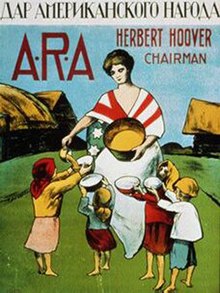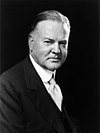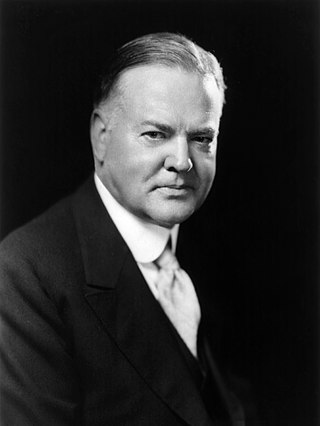
Herbert Clark Hoover was an American politician and humanitarian who served as the 31st president of the United States from 1929 to 1933. A member of the Republican Party, he held office during the onset of the Great Depression. A wealthy mining engineer before his presidency, Hoover led the wartime Commission for Relief in Belgium, served as the director of the U.S. Food Administration, and served as the U.S. secretary of commerce.

After the Russian Revolution, in which the Bolsheviks took over parts of the collapsing Russian Empire in 1918, they faced enormous odds against the German Empire and eventually negotiated terms to pull out of World War I. They then went to war against the White movement, pro-independence movements, rebellious peasants, former supporters, anarchists and foreign interventionists in the bitter civil war. They set up the Soviet Union in 1922 with Vladimir Lenin in charge. At first, it was treated as an unrecognized pariah state because of its repudiating of tsarist debts and threats to destroy capitalism at home and around the world. By 1922, Moscow had repudiated the goal of world revolution, and sought diplomatic recognition and friendly trade relations with the capitalist world, starting with Britain and Germany. Finally, in 1933, the United States gave recognition. Trade and technical help from Germany and the United States arrived in the late 1920s. After Lenin died in 1924, Joseph Stalin, became leader. He transformed the country in the 1930s into an industrial and military power. It strongly opposed Nazi Germany until August 1939, when it suddenly came to friendly terms with Berlin in the Molotov–Ribbentrop Pact. Moscow and Berlin by agreement invaded and partitioned Poland and the Baltic States. Stalin ignored repeated warnings that Hitler planned to invade. He was caught by surprise in June 1941 when Nazi Germany invaded the Soviet Union. The Soviet forces nearly collapsed as the Germans reached the outskirts of Leningrad and Moscow. However, the Soviet Union proved strong enough to defeat Nazi Germany, with help from its key World War II allies, Britain and the United States. The Soviet army occupied most of Eastern Europe and increasingly controlled the governments.

Throughout Russian history famines, droughts and crop failures occurred on the territory of Russia, the Russian Empire and the USSR on more or less regular basis. From the beginning of the 11th to the end of the 16th century, on the territory of Russia for every century there were 8 crop failures, which were repeated every 13 years, sometimes causing prolonged famine in a significant territory. The causes of the famine were different, from natural and economic and political crises; for example, the Great Famine of 1931–1933, colloquially called the Holodomor, the cause of which was the collectivization policy in the USSR, which affected the territory of the Volga region in Russia, Ukraine and Kazakhstan.
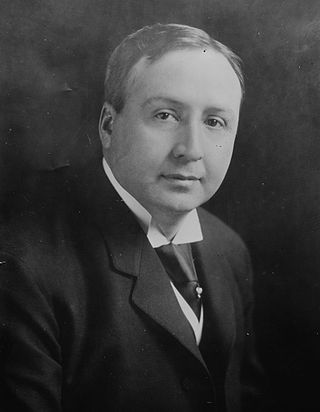
Joseph Irwin France was a Republican member of the United States Senate, representing the State of Maryland from 1917 to 1923.
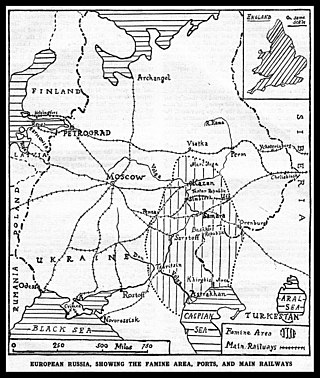
The Russian famine of 1921–1922, also known as the Povolzhye famine was a severe famine in the Russian Soviet Federative Socialist Republic that began early in the spring of 1921 and lasted until 1922. The famine resulted from the combined effects of severe drought, the continued effects of World War I, economic disturbance from the Russian Revolution, the Russian Civil War, and failures in the government policy of war communism. It was exacerbated by rail systems that could not distribute food efficiently.

American Relief Administration (ARA) was an American relief mission to Europe and later post-revolutionary Russia after World War I. Herbert Hoover, future president of the United States, was the program director.
The Workers International Relief (WIR) — also known as Internationale Arbeiter-Hilfe (IAH) in German and as Международная рабочая помощь in Russian — was an adjunct of the Communist International initially formed to channel relief from international working class organizations and communist parties to famine-stricken Soviet Russia. The organization, based in Berlin, later produced films and coordinated propaganda efforts on behalf of the USSR.

Relations between the Soviet Union and the United States were fully established in 1933 as the succeeding bilateral ties to those between the Russian Empire and the United States, which lasted from 1776 until 1917; they were also the predecessor to the current bilateral ties between the Russian Federation and the United States that began in 1992 after the end of the Cold War. The relationship between the Soviet Union and the United States was largely defined by mistrust and tense hostility. The invasion of the Soviet Union by Germany as well as the attack on the U.S. Pacific Fleet at Pearl Harbor by Imperial Japan marked the Soviet and American entries into World War II on the side of the Allies in June and December 1941, respectively. As the Soviet–American alliance against the Axis came to an end following the Allied victory in 1945, the first signs of post-war mistrust and hostility began to immediately appear between the two countries, as the Soviet Union militarily occupied Eastern European countries and turned them into satellite states, forming the Eastern Bloc. These bilateral tensions escalated into the Cold War, a decades-long period of tense hostile relations with short phases of détente that ended after the collapse of the Soviet Union and emergence of the present-day Russian Federation at the end of 1991.
The 1921–1922 famine in Tatarstan was a period of mass starvation and drought that took place in the Tatar ASSR as a result of the Russian Civil War, in which 500,000 to 2,000,000 peasants died. The event was part of the greater Russian famine of 1921–22 that affected other parts of what became the Soviet Union, in which up 5,000,000 people died in total. According to Roman Serbyn, a professor of Russian and East European history, the Tatarstan famine was the first man-made famine in the Soviet Union and systematically targeted ethnic minorities such as Volga Tatars and Volga Germans.
The Soviet famine of 1946–1947 was a major famine in the Soviet Union that lasted from mid-1946 to the winter of 1947 to 1948.

People's Commissariat for Posts and Telegraphs of the RSFSR, known shortly as the Narkompochtel, was the central organ of government of the RSFSR that was in charge of the organisation and development of the different forms of communication, including postal service. It was founded in Petrograd on 7 November [O.S. 25 October] 1917 from the Russian Ministry of Posts and Telegraphs and retained its organisational structure.

Paxton Pattison Hibben had a short but eventful career as a diplomat, journalist, author and humanitarian. After graduation from college he received a diplomatic appointment and served for seven years at a number of foreign posts. He then joined the Progressive Party and assisted Theodore Roosevelt in his 1912 presidential campaign. Hibben became a roving war correspondent in World War I, reporting on military action from several European fronts. He served on a military relief commission in Armenia after the war, and went on to assist the Red Cross in its efforts to rescue children in the Russian famine of 1921-23. Hibben wrote extensively on politics and international affairs, and published books on the Russian famine, the Greek monarchy, Henry Ward Beecher and William Jennings Bryan. His untimely death at age forty-eight was honored by the Russian government with a hero's burial in a Moscow cemetery.
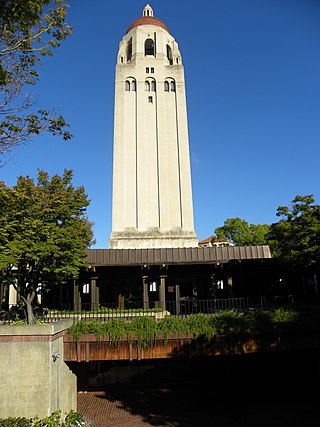
The Hoover Institution Library and Archives is a research center and archival repository located at Stanford University, near Palo Alto, California in the United States. Built around a collection amassed by Stanford graduate Herbert Hoover prior to his becoming President of the United States, the Hoover Library and Archives is largely dedicated to the world history of the 20th and 21st centuries. It includes one of the largest collections of political posters in the world.
Frank Alfred Golder was an American historian and archivist specializing in the history of Russia. Golder is best remembered for his work in the early 1920s building the seminal collection of Slavic language materials residing today at the Hoover Institution Library and Archives at Stanford University in California.
The American Volga Relief Society was a German American non-governmental organization that provided relief and supplies to ethnically German settlements in the area around the Volga River. The group was active following World War I, during the period between 1921 and 1924. The organization officially disbanded in 1926, though private donations continued until the 1930s.

Bread and Authority in Russia, 1914—1921, is a history book by Lars T. Lih about the food crisis in the Russian Empire and Soviet Union.
The following is a list of important scholarly resources related to Herbert Hoover, the 31st president of the United States. For recent work see Ellis W. Hawley (2018). For older studies see Patrick G. O’Brien and Philip T. Rosen, (1981), 25–42, 83–99 and Patrick G. O’Brien, (1988).

Foreign policy of Herbert Hoover covers the international activities and policies of Herbert Hoover for his entire career, with emphasis to his roles from 1914 to 1933.

The 1921–1923 famine in Ukraine was a disaster that mostly occurred in the southern steppe region of Ukraine. The number of fatalities is estimated between 200,000 and 1,000,000, but no systematic records were then made.
Central Commission for the Struggle against Consequences of Famine was a Central Commission under the All-Russian Central Executive Committee created to combat the consequences of the famine of 1921-1922. It was the successor of Pomgol and was created by a resolution of the All-Russian Central Executive Committee. They collaborated with foreign philanthropic institutions that were allowed to provide relief to the Soviet population. Posledgol mainly planned and supervised relief activities. The commission received resources from state and donations by population. They portended enormous complications and inadequacies in handling the actual situation in the famine areas.


